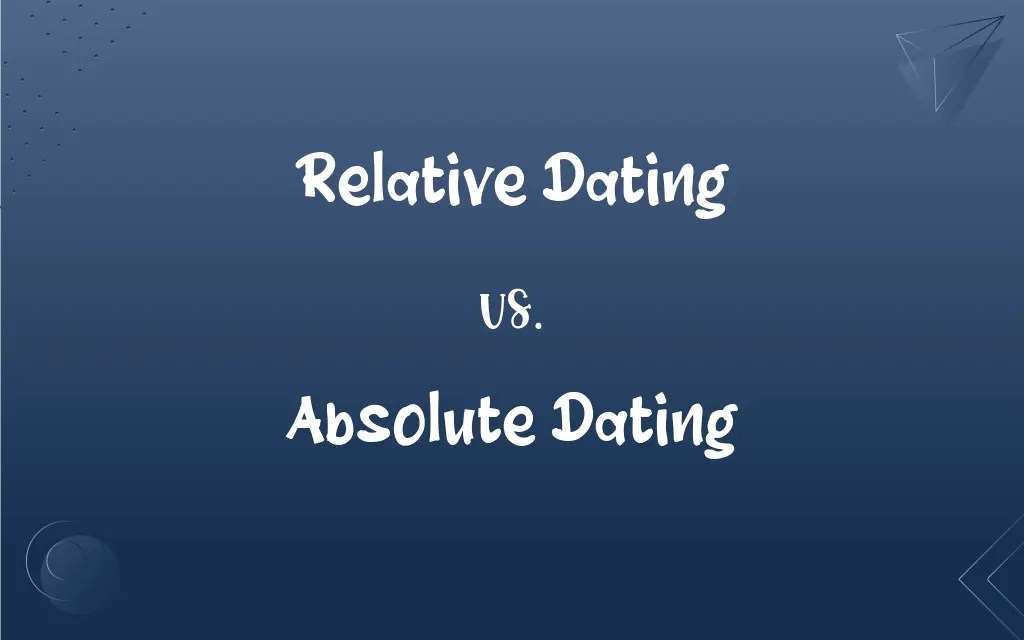Relative Dating vs. Absolute Dating: What's the Difference?
Edited by Janet White || By Harlon Moss || Updated on October 2, 2023
Relative dating determines the chronological sequence of events, while absolute dating provides the actual age or a specific range of years for an event or object.

Key Differences
Relative dating in archaeology and geology entails deciphering the chronological order of events or materials without knowing their absolute age. On the other hand, absolute dating employs various techniques to ascertain a quantitative age or time period for an artifact, geological feature, or fossil.
The principle behind relative dating revolves around determining the sequential order of past events without necessarily determining their precise age. Conversely, absolute dating utilizes scientific methods, such as radiometric dating, to quantify the actual age of an object or event in years.
In the realm of paleontology and archaeology, relative dating helps researchers to build a chronological framework to organize the historical and prehistorical events or artifacts. Absolute dating, meanwhile, permits scientists to pinpoint specific time frames, providing a more precise chronology.
While relative dating methods like stratigraphy can provide valuable clues regarding the sequence of historical events or layers, they do not provide a specific date. Absolute dating, using methods like carbon dating, provides a definitive chronological context in which artifacts or events occurred.
Although both relative dating and absolute dating offer critical insights into historical and geological timelines, they are often used complementarily in scientific research to build a coherent chronological framework that integrates both sequential and quantitative temporal data.
ADVERTISEMENT
Comparison Chart
Determination of Age
Does not determine specific age
Determines specific age or range
Methodology
Uses principles like stratigraphy
Utilizes techniques like radiometric dating
Chronological Context
Provides a sequence
Provides exact or range of years
Data Precision
Less precise, order only
High precision, exact numbers
Applicability
Often applied where absolute dating is not possible
Applied when chronological age is needed
ADVERTISEMENT
Relative Dating and Absolute Dating Definitions
Relative Dating
Relative dating establishes the chronological sequence of geological layers.
The geologist used relative dating to determine that the riverbed was older than the floodplain.
Absolute Dating
Absolute dating techniques measure isotopic changes to calculate chronological age.
The cave painting was aged at approximately 20,000 years through uranium-series absolute dating.
Relative Dating
Relative dating utilizes the principle of superposition to determine sequences of events.
The archaeologist applied relative dating, observing that the pottery was from a later period than the tools below it.
Absolute Dating
Absolute dating can use radioactive decay as a clock to measure the age of materials.
Through absolute dating using potassium-argon decay, the rock was found to be 2 million years old.
Relative Dating
Relative dating depends on stratigraphic principles to establish a chronological order.
Relative dating indicated that the burial site was subsequent to the construction of the nearby monument.
Absolute Dating
Absolute dating utilizes scientific methods to determine the exact age of an artifact or event.
Carbon-14 absolute dating established that the manuscript was 1500 years old.
Relative Dating
Relative dating does not pinpoint the exact age of fossils but indicates whether one is older or younger than another.
By studying strata, paleontologists utilize relative dating to establish a timeline of species evolution.
Absolute Dating
Absolute dating employs techniques such as dendrochronology to date events.
The ancient shipwreck was precisely dated to 1256 AD using absolute dating via tree-ring analysis.
Relative Dating
Relative dating in archaeology helps construct a timeline of events based on their relative positions in layers.
By employing relative dating, it was concluded that the city walls were built after the oldest tombs.
Absolute Dating
Absolute dating provides a defined chronological age or range for fossils and artifacts.
With absolute dating, the fossil was estimated to be roughly 65 million years old.
FAQs
How does absolute dating provide chronological age?
Absolute dating uses scientific methods, such as radiometric dating, to calculate the exact or a range of age in years.
What is the purpose of relative dating?
Relative dating aims to determine the sequential order of past events or materials without providing an exact age.
What is a limitation of absolute dating?
Absolute dating can be limited by material suitability and the half-life of isotopes used.
What principles guide relative dating?
Relative dating follows principles like superposition and horizontality to establish chronological sequences.
Can relative dating give accurate age estimates?
No, relative dating only provides a sequence of events without exact age estimates.
How does faunal succession relate to relative dating?
Faunal succession, indicating that different animal species succeed one another in a predictable manner, is a principle used in relative dating.
Can absolute dating determine the age of the Earth?
Yes, absolute dating of the Earth's oldest rocks and minerals provides estimates of the Earth's age.
Can absolute dating be used for any type of material?
Absolute dating is applicable to materials that can be analyzed using specific techniques, like radiometric dating for rocks or carbon dating for organic remains.
What are common methods used in absolute dating?
Common methods include radiometric dating, dendrochronology, and thermoluminescence dating.
Is relative dating always applicable in archaeological studies?
Not always, as it relies on sufficient stratigraphic information and discernible differences between layers or artifacts.
Can relative and absolute dating methods be used together?
Yes, they often complement each other in establishing full and accurate chronological frameworks.
Why might researchers prefer absolute dating in certain contexts?
Absolute dating provides a clear chronological age, which is crucial for understanding timing and rates of past events.
What role does stratigraphy play in relative dating?
Stratigraphy helps determine the relative ages of rock layers and the fossils within them through layer positioning and composition.
In what fields is relative dating commonly used?
Relative dating is frequently utilized in fields like archaeology, paleontology, and geology to establish chronological sequences.
Can absolute dating methods be used in all geological materials?
No, certain materials and conditions are required, such as the presence of specific isotopes for radiometric dating.
What is the principle of superposition in relative dating?
It states that in undeformed stratigraphic sequences, the oldest layers are at the bottom and the youngest at the top.
How do scientists select the appropriate method of absolute dating?
Scientists consider material type, age, and isotopic content to select a suitable absolute dating method.
When might relative dating be more practical than absolute dating?
Relative dating might be more practical in contexts lacking suitable materials or conditions for absolute dating methods.
How accurate is absolute dating?
While precise, the accuracy of absolute dating can be influenced by factors like contamination and proper sample preparation.
What type of materials is absolute dating most effective with?
Organic materials, rocks, and minerals containing suitable isotopes are often apt for absolute dating.
About Author
Written by
Harlon MossHarlon is a seasoned quality moderator and accomplished content writer for Difference Wiki. An alumnus of the prestigious University of California, he earned his degree in Computer Science. Leveraging his academic background, Harlon brings a meticulous and informed perspective to his work, ensuring content accuracy and excellence.
Edited by
Janet WhiteJanet White has been an esteemed writer and blogger for Difference Wiki. Holding a Master's degree in Science and Medical Journalism from the prestigious Boston University, she has consistently demonstrated her expertise and passion for her field. When she's not immersed in her work, Janet relishes her time exercising, delving into a good book, and cherishing moments with friends and family.































































